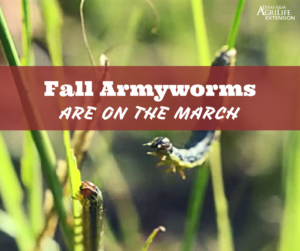Armyworm Fact Sheet 2019 revision
Cooke County Farmers and Ranchers,
October 8, 2018
Fall Armyworms again? If you are seeing an uptick in moths this week, you’re not alone. A short post on these moths from Dr. Mike Merchant, in case you have questions. https://citybugs.tamu.edu/2018/10/08/miller-moths/
The Battle with Fall Armyworms
Well I warned folks in my weekly Crop & Cattle Report a few weeks ago to start scouting for Fall Armyworms because I felt like we had the prime weather conditions to hatch them out and this past week we have seen a horrific invasion of the pesky little creature. They are all over North Tx and the phone is ringing off the hook with questions. So let’s answer some questions that are always ask.
How to identify them?
Well they are green, brown or black with white to yellowish lines running from head to tail. A distinct white line between the eyes forms an inverted “Y” pattern on the face. Four black spots aligned in a square on the top of the segment near the back end of the caterpillar.
Where do they come from and what is their cycle?
Moths start migrating up from south TX after spring and lay eggs(2000) in the soil, they hatch into caterpillars(after 7-9 days) starting about 1/8 inch long and grow for 14-21 days to 1.5 inches when mature. During this time is when they do the damage to our grass, crops and lawns. After this stage they pupate in the ground for about 7-13 days and become moths again which can live up to 21 days but usually average 10 days. So as you can see their life cycle can range from 21 up to 40 days.
What can I use to control them?
First let’s talk about your controlling them around the house and in your lawn. There are insecticides you can use that are a liquid spray concentrate, products such as Seven(Carbaryl), Cyonara 9.7, Bifen XTS, etc… Although not as effective as spray concentrates one can use granules such as Seven, Bayer Advanced Complete Insect Killer(is safe for your pets & children as long as it was applied as directed on the product label). If you want to try products that are biological(natural) then any liquid thuricide concentrate with Bt caterpillar control will work. Also Spinosad products are available.
What about control in my pasture and hay field?
There are several products out there that will work but the length of action(residual) may vary and so will the price so choose wisely depending on your situation. And there are products that are restricted and those that are over the counter. Products that are recommended by our Texas A&M Research Entomologist that are general use(not restricted), with no grazing or haying restrictions include Prevathon with rynaXypyr, ($15-20/acre) Seven and Malathion($2-6/acre) Intrepid 2F etc… Products that are restricted use with no grazing but a 7 day restriction on haying are Besiege(Prevathon + Lambda-cyhalothrin and $15-20)) any product with Lambda-Cyhalothrin like LambStar Plus, Karate etc… will work as a contact insecticide and cost $2-10. The higher end products have a 7-14 day residual unlike the lower cost products which are only a few days. For cool season grasses such as wheat and oats you can use Cobalt Advanced and Warrior, both have a 14 day restriction on grazing and haying.
PLEASE ABOVE ALL READ AND FOLLOW LABEL DIRECTIONS ON ALL PRODUCTS USED!!! I have an Armyworm Fact Sheet on our website so just select the “Armyworm Fact Sheet” link above for more information. If you hire it done the application costs will run you $6-8/acre so add that on to your chemical costs. Please contact me if you have questions or concerns at 940-668-5412 or email me at marty.morgan@ag.tamu.edu
Marty Morgan, Ag Agent


